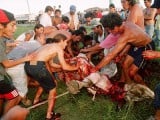Μίλησε πάλι ο επιστήμονας...
κοψε τις μαλακιες ρε προσκυνημενε, και βαλε και καμια πηγουλα στις παπαριες που ανεβαζεις, στην αργεντινη απο το 1999 ειχαν παει οι φιλοι σου του ΔΝΤ και μεχρι το 2003 διελυσαν τη χωρα και οδηγησαν εκατομμυρια ανθρωπος στην ανεχεια και τις αυτοκτονιες!!! Οσο για τις αυτοκτονιες και την ανεργια, αισιως εχουμε ξεπερασει εδω τις 4500 αυτοκτονιες και τους 1700000 ανεργους (μεσα σε αυτους βεβαια δεν περιλαμβανονται οι ελ.επαγγελματιες, οι μαγαζατορες και οι ημιαπασχολουμενοι που σε απολυτα νουμερα ο αριθμος διπλασιαζεται). Παρε και μια αναφορα τι εγινε στην αργεντινη αφου φυγανε τα κορακια που ξεσκιζουν την ελλαδα σημερα
Recovery[edit source | editbeta]
Evolution of the Argentine GNP, 1999–2004.
Foreign currency reserves of Argentina's central bank, in millions of USD.
Duhalde eventually stabilised the situation to a certain extent, and called for elections. On 25 May 2003, Néstor Kirchner took office as the new president. Kirchner kept Duhalde's Minister of Economy, Roberto Lavagna, in his post. Lavagna, a respected economist with centrist views, showed a considerable aptitude at managing the crisis, with the help of heterodox measures.
The economic outlook was completely different from that of the 1990s; the devalued peso made Argentine exports cheap and competitive abroad and discouraged imports. In addition, the high price of soy in the international market produced massive amounts of foreign currency (with China becoming a major buyer of Argentina's soy products).
The government encouraged import substitution and accessible credit for businesses, staged an aggressive plan to improve tax collection, and allocated large sums for social welfare, while controlling expenditure in other fields.[citation needed]
The peso slowly rose, reaching a 3-to-1 rate to the dollar. Agricultural exports grew and tourism returned.
The huge trade surplus ultimately caused such an inflow of dollars that the government was forced to begin intervening to keep the peso from rising further, which would break the tax collection scheme (largely based on import taxes and royalties) and discourage further reindustrialisation. The central bank started rebuilding its dollar reserves.
By December 2005, foreign currency reserves had reached US$28 billion (they were later reduced by the payment of the full debt to the IMF in January 2006). The downside of this reserve accumulation strategy is that the dollars had to be bought with freshly issued pesos, which risked inflation. The central bank sterilized its purchases by selling Treasury letters. In this way the exchange rate stabilised near 3:1.
President Néstor Kirchner and Economy Minister Roberto Lavagna discuss policy, August, 2004.
The currency exchange issue was complicated by two mutually opposing factors: a sharp increase in imports since 2004 (which raised the demand for dollars), and the return of foreign investment (which brought fresh currency from abroad) after the successful restructuring of about three quarters of the external debt. The government set up controls and restrictions aimed at keeping short-term speculative investment from destabilising financial markets.
Argentina's recovery suffered a minor setback in 2004 when rising industrial demand caused a short-lived energy crisis. Argentina managed to return to growth: GDP jumped 8.8% in 2003, 9.0% in 2004, 9.2% in 2005, 8.5% in 2006 and 8.7% in 2007. Though wages averaged a 17% annual increase from 2002-2008(jumping 25% in the year to May 2008),[50] inflation ate away at these increases: 12.5% in 2005; 10% in 2006; nearly 15% in 2007 and over 20% during 2008.[citation needed]
σαλτα και κιχου τωρα







